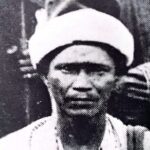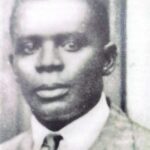MAKAVORAY
- 5 Min Read
Makavoray of Tikonko (circa 1830-1897) was a powerful warrior-king who played a vital peacekeeping role among warring chiefs in southern Sierra Leone in the second half of the 19th century. Unlike most of his contemporaries, who were interested only in self-aggrandisement through war, this thoughtful ruler often acted as a check on his unruly juniors.
A descendant of Momoh Kukuwa, Makavoray’s proper name was ‘Meccavolo’ meaning ‘the day of Mecca,’ because he was apparently born on the day a Muslim pilgrim returned from Mecca. He was trained from youth as a warrior, and by the middle of the 19th century had become the ruler of a substantial state centered on Tikonko on the lower reaches of the Bum River. In his turn, he trained two of the most famous Mende professional warriors of the later 19th century, Ndawa and Makaya.
Tikonko, however, was constantly quarreling with its neighbour, the state of Bumpe. For much of the second half of the 19th century, these rival states were either at war with each other, or fighting as allies of opposing groups in the lower Bum basin. Despite this, Makavoray established himself as a leading ruler in the hinterland.
The colonial administration in Freetown was fully aware of Makavoray’s importance. Particularly during the 1880s, he was in constant demand to settle disputes in areas outside his own territorial frontiers. In 1886, he organised a special peace Poro (secret society meeting) to bring an end to the war against the Lugbu. He also received repeated appeals from the administration to restrain Makaya and Ndawa, his onetime warrior pupils, from attacking territories dangerously close to British interests on the Gallinas coast in the far south of Sierra Leone. It was not until Makavoray intervened that Ndawa, who had attacked the town of Bandasuma and captured its ruler, Madam Dalo, could be persuaded to release her.
In 1889, there started a two-year period of rapid treaty-making as a way of preparing for the declaration of the Protectorate over the hinterland. In March, 1889, Makavoray signed a ‘Treaty of Friendship’ with Governor Sir James Shaw Hay (term of office 1888-91) for which he received a stipend of £20 per annum. Two months later, at a meeting held at Bandasuma on the Moa River to reconcile differences among rulers, a similar “Treaty of Friendship’ was signed by King Nyagua, Makavoray’s northeastern neighbour with whom he had quarreled. Preceding the signing, Hay had settled the disagreement between the two chiefs who publicly shook hands and embraced each other.
The administration, who looked to ‘treaty chiefs’ for cooperation, continued to turn to Makavoray for assistance. Shortly after the meeting at Bandasuma, he had to intervene in a long-standing conflict among Kaa-Mende chiefs grouped under two ring-leaders, Moigula and Vonjo. Although these were technically sub-chiefs of Madam Yoko, chief of Kpaa-Mende, she was powerless to control them. There were serious disturbances in the Kpaa-Mende state, provoked by incidents which occurred on the Mende-Temne frontier. A Temne warrior, Sembu Kamara of Kumabai, had carried out raids in Kpaa-Mende country at the invitation of his Mende allies. One of his co-fighters had escaped to upper Mende land where he was captured by chief Vonjo, handed over to Makavoray (who had been asked to help in his capture, and sent to Freetown under police escort.
This caused rival factions to form. Many chiefs in lower Kpaa-Mende grouped together under Moigula of Gondama, determined to fight Vonjo for having captured Sembu Kamara’s warrior. The colonial administration was uneasy and sent in Frontier Police under Sub-Inspector Charles Taylor, who persuaded some of the chiefs to withdraw their support from Moigula. But the matter did not end here, for Madam Yoko had little authority over her sub-chiefs. Makovoray, asked by Taylor to intervene, persuaded Vonjo to put a stop to his attacks, but Moigula continued to fight and Madam Yoko had to flee to Freetown for protection as the situation deteriorated.
Several meetings were summoned by the administration in Freetown and in the hinterland, but to no purpose. Moigula avoided a meeting that had been arranged at Yele on the Taia River, raided Vonjo’s country, and fled to Chief Foray in Kono in the eastern part of Sierra Leone. The administration could do no more except to station police at key points and prevent arms supplies from reaching Moigula. Finally, Makavoray supported Vonjo in an offensive against Moigula and Foray, and hostilities ended around 1893 with the capture of one of Foray’s towns by Vonjo.
Makavoray emerged as a warrior-king of unusual statesmanship, able to see beyond immediate issues of territorial squabbling. He lived to see the Protectorate proclaimed in 1896, but died the following year before discontent erupted in the resistance struggles of 1898.He was succeeded by Sandi, one of his relations, all descended from the first founder settler, Momoh Kukuwa.
ARTHUR ABRAHAM




